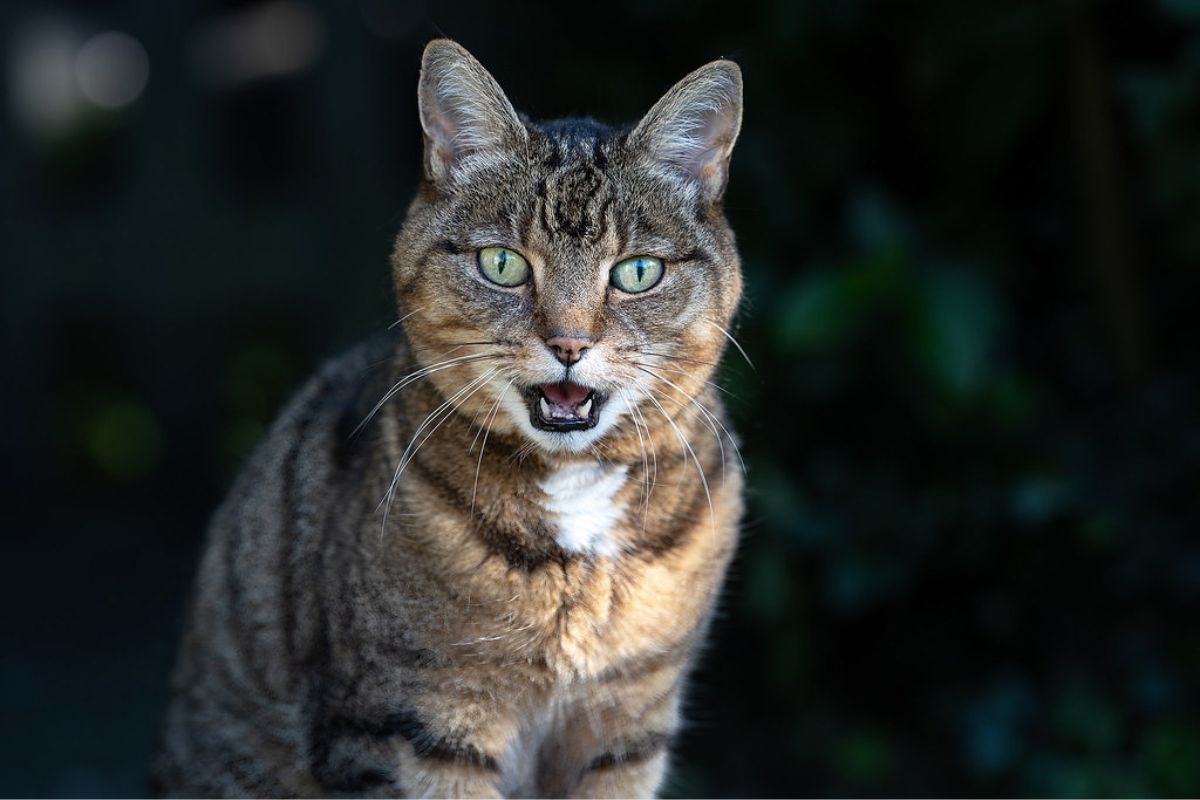Cats are well-known for their rich vocabulary. They produce a wide variety of sounds to communicate their emotions, intentions, and needs to humans and other cats. Their sounds often vary in context, volume, pitch, and duration. Understanding these sounds can help us create a stronger bond with our feline friends by responding appropriately to their needs, emotions, and behaviors.
Here is a list of common and important cat sounds and noises, and what they generally mean:
1. Meow
Cats meow mainly to communicate with humans, not with other cats. This sound varies in tone and can indicate anything from hunger to a simple greeting. While kittens meow to catch their mother’s attention, adult cats usually meow to signal their humans, often to demand food or attention.
2. Purr
A purr is a soft, vibratory sound cats make when they’re content. However, cats also purr when they’re injured or scared, serving as a self-soothing mechanism. For humans, a cat’s purr typically signals contentment, but it’s essential to observe the context since it might also indicate distress.
3. Hiss
A hiss is a sharp, steam-like sound cats and some other animals make when threatened or scared. It serves as a warning to other animals or humans to back off, signaling fear or discomfort. This ominous sound is a clear indication that the animal is not in a friendly mood.
4. Growl
A growl is a low, guttural vocalization used as a warning among many animals, including cats and dogs. It can signal aggression or playfulness, depending on the context. For humans, a growling animal usually means it’s best to keep distance, though in some cases, it might just be part of a playful interaction.
5. Chatter
Chatter is a quick, repetitive sound often made by cats while observing birds or by primates. It indicates excitement or frustration. Whether directed at other animals or humans, chattering is commonly associated with a heightened state of emotion, such as anticipation or eagerness.
6. Chirrup (or Trill)
The chirrup, a friendly greeting sound made by cats and recognized among birds, is a rolling, high-pitched call. For cats, it’s a way to say hello to humans or other cats. It signifies a pleasant and sociable mood.
7. Yowl
Yowling is a long, drawn-out meow, often loud and melodic, indicating distress, discomfort, or aggression. It is generally a sign of significant upset in cats, either directed towards other animals or expressing an issue to their human companions.
8. Scream
Screams are loud, high-pitched sounds signaling extreme fear, distress, or pain. Animals across various species, including humans, emit screams when in dire situations. It’s a universal sound of alarm that demands immediate attention.
9. Bleat
A bleat is a soft, plaintive sound typically made by goats, sheep, and calves, expressing discomfort or separation anxiety. When animals bleat, they’re usually seeking attention or signaling their distress, a cue for others in their group or humans to respond.
10. Spit
Spitting is a sharp, expelling sound used defensively or to show aggression, particularly among cats. When an animal spits, it’s a clear signal of its displeasure or fear, often used to warn off other animals or humans.
Understanding Cat Sounds: Why It Matters
Understanding the meaning of cat sounds is paramount for various reasons
- Improves Communication: Knowing the meaning of different sounds will improve communication between you and your feline companion. It allows you to respond appropriately, whether it’s feeding time, cuddling time, or playtime. It also allows you to discern when your cat wants to be left alone.
- Promotes Your Cat’s Well-being: Some sounds may indicate your cat’s satisfaction or discomfort. Recognizing a happy purr or an anxious yowl can significantly influence your cat’s well-being, alerting you to potential health problems or needs that your cat may have.
- Enhances Bonding: Understanding your cat’s language leads to a stronger connection. It helps you cater to their specific needs, leading to a happier and more content pet. Reacting to their sounds can make cats feel understood, leading to a more nurturing and loving relationship.
- Prevents Misunderstandings: Certain sounds like hissing or growling can serve as warnings. Recognizing these can prevent possible injuries or mishaps caused by misunderstanding your cat’s boundaries.
- Aids in Training: When you understand your cat’s way of communication, it can make training more straightforward. You know when they’re excited, content, annoyed, or in agreement with the commands you’re providing.
In essence, learning to understand your cat’s sounds and their meanings lead to healthier, happier, and safer environments for both you and your pet.

